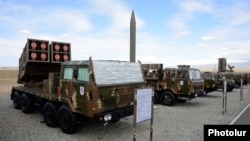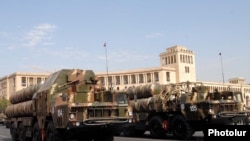Armenia will spend a $200 million loan provided by Russia on buying, among other things, “long-range” Russian-made weapons, the Defense Ministry in Yerevan said on Tuesday.
“With that sum we will acquire new military hardware, including both offensive and defensive weapons, as well as new equipment as part of our program of a large-scale modernization of the army,” the ministry spokesman, Artsrun Hovannisian, told RFE/RL’s Armenian service (Azatutyun.am).
Hovannisian declined to shed more light on those weapons, saying only that Armenia has not had some of them in its military arsenal until now.
The Russian “export credit” repayable in 13 years is designed to finance fresh Russian arms supplies to the Armenian Armed Forces. Officials in Yerevan say they will be purchased at discount prices.
A Russian-Armenian agreement on the loan disbursement was signed on June 26 and ratified by Armenia’s parliament on July 2. The ratification coincided with a report by Russia’s official TASS news agency saying that Moscow and Yerevan are now negotiating on the delivery of advanced Iskander-M missiles to the Armenian army.
Hovannisian declined to deny or confirm the report. “I cannot say anything concrete,” he said. “We are discussing with the Russian side acquisition of various types of offensive weaponry.” Those include long-range weapons, he added without elaborating.
With a firing range of around 500 kilometers, the Iskander-M systems are one of the most potent weapons of their kind that could have important implications for the military balance in the Nagorno-Karabakh conflict. In particular, they would make Azerbaijan’s vital oil and gas infrastructure even more vulnerable to Armenian missile strikes in the event of a renewed war for Karabakh.
Russia has not exported Iskander-Ms to any foreign state so far.
News of the latest Russian-Armenian arms dealings emerged amid street protests in Yerevan against a controversial electricity price hike initiated by Armenia’s Russian-owned power distribution monopoly. The nonstop protests seem to have raised fears in Moscow of the kind of Western-backed revolution that toppled Ukraine’s pro-Russian government last year. Observers have suggested that the Russians are now trying to placate disgruntled Armenians and shore up President Serzh Sarkisian’s positions.
Manvel Sargsian, director of the Armenian Center for National and International Studies, described the Russian military aid as a “political gesture” to Yerevan. “That political gesture seems to have been taken seriously by everyone,” he said.
Azerbaijan, meanwhile, expressed concern at the Russian loan. An Azerbaijani Foreign Ministry spokesman said the weapons to be purchased with that loan must not be deployed on “Azerbaijan’s territories occupied by Armenia.”
Azerbaijan itself has bought at least $4 billion of Russian weapons in the last several years. The Russian-Azerbaijani defense contracts have been criticized by Armenia’s government, opposition groups and media.

